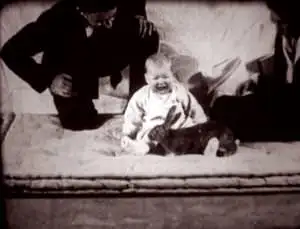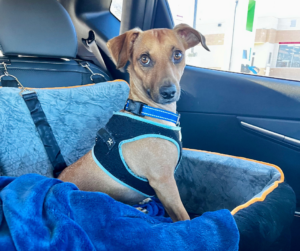Michael Baugh CDBC CPDT-KSA
It turns out people rarely ask. Instead, they just assume that if we comfort a fearful dog that we must be reinforcing fear. They grow even more concerned if we use food. The answer to the unasked question is layered and a bit technical. I usually don’t go into detail. I just reassure my fearful client that we are not, in fact, reinforcing or rewarding their dog’s fear.
 The truth is we can teach fear, but not in the way most people are worried about. The process is called associative learning, sometimes called classical conditioning or (more commonly) Pavlovian conditioning. Don’t go to sleep. It’s pretty interesting stuff. When I was much younger I taught my dog to stay out of the basement. When she was a puppy, the first time she peered down the basement steps I dropped a book and it made a loud bang on the hardwood floor. She startled and ran away from the door, never to return again. Ever. Seriously, she never went into the basement. I associated the open basement door with a loud and startling noise. The open door was forever frightening enough that she never approached it again. I taught her to be afraid of it.
The truth is we can teach fear, but not in the way most people are worried about. The process is called associative learning, sometimes called classical conditioning or (more commonly) Pavlovian conditioning. Don’t go to sleep. It’s pretty interesting stuff. When I was much younger I taught my dog to stay out of the basement. When she was a puppy, the first time she peered down the basement steps I dropped a book and it made a loud bang on the hardwood floor. She startled and ran away from the door, never to return again. Ever. Seriously, she never went into the basement. I associated the open basement door with a loud and startling noise. The open door was forever frightening enough that she never approached it again. I taught her to be afraid of it.
Some trainers teach dogs to fear the beep on a shock collar. The dog only has to get shocked once after the beep for it to work. It’s a learned fear. Even a minor car crash can teach dogs to be afraid of the car forever. Car sickness can do that too. I once worked with a dog who was terrified of the garbage truck. At first she learned to fear the sound of the truck in the distance. Before too long she had learned to fear Wednesday mornings (garbage day). Benign things, a beep, a car ride, or a day of the week, become frightening because of the terror they once predicted predict.
 John Watson became both renown and notorious when, building on Pavlov’s findings, he conducted the infamous Little Albert experiment. He taught a 9-month old baby to fear soft furry animals by associating them with a loud startling noise. The child ended up having a phobia of rats, bunnies, even dogs. Ethical restrictions would prohibit this type of research today. Still, governments used this part of behavior science to elicit extreme fear responses associated with otherwise unremarkable words, gestures, or environmental triggers. They did this by associating those things with torture including beatings, shock, sleep deprivation, drugs, and hypnosis. It’s a dark and not-so-distant part of our history and an interesting revelation of how emotions work.
John Watson became both renown and notorious when, building on Pavlov’s findings, he conducted the infamous Little Albert experiment. He taught a 9-month old baby to fear soft furry animals by associating them with a loud startling noise. The child ended up having a phobia of rats, bunnies, even dogs. Ethical restrictions would prohibit this type of research today. Still, governments used this part of behavior science to elicit extreme fear responses associated with otherwise unremarkable words, gestures, or environmental triggers. They did this by associating those things with torture including beatings, shock, sleep deprivation, drugs, and hypnosis. It’s a dark and not-so-distant part of our history and an interesting revelation of how emotions work.
Yes, fear can be learned. Lot’s of dogs have learned to be afraid of people, places, and situations. But, using food never taught a dog to be afraid. The function of fearful behavior is to escape something scary. It’s not to earn a bit of cheese. Maybe this example will help.
What if I gave my dog some cheese for looking at a man she was afraid of. This guy is cool; he’s just sitting there. But, what if my hypothetical dog has had a hard time with men in the past? What if now they are all pretty much suspect? So, she looks at this guy with her ears back and tail tucked (obviously afraid). Is offering the cheese going to make her more fearful of men in the future (because that is the definition of reinforcement). The short answer is no. Let’s break this down.
- My dog refuses the food. This is a typical behavior when dogs are very afraid of something. The food does not register. In this case the food has no impact on future behavior or emotions. My dog remains roughly as afraid of the man as she was before.
- My dog doesn’t get a chance to take food because the man gets up, talks to her, and reaches to pet her. In this case, her possible curiosity is met with the exact thing she feared the most. Her fear would be maintained or made worse.
- My dog takes the food. Better yet, I present a conditioned marker (like a click or the word “yes”) when she looks. She then looks back at me and takes the food. I’ve just reinforced looking at the man and then looking away. I’ve also associated the sight of a man with food (not a startling or painful outcome). I now have the beginning of a new behavior pattern: See man; Look at him; Then look to me. I also have the beginning of some new associative learning (Seeing a man predicts food from me). In this case fear is actually reduced.
Plot twist. We need to get the order of events correct. If we present the food first and bribe the dog to approach the man, the dog may play along. She may even take the food. But if she gets too close and the man scares her our whole plan falls apart. Food + man + startle = Fear. Before long our dog will grow suspect of the food itself, and rightly so. Food in that context will elicit a fear response (likely retreat and avoidance). Dog guardians often mistake this as the dog not being interested in food or simply being stubborn. Not so. We accidentally taught her that food in this case is not a predictor of good things to come. It’s a trick.
Bottom line: Fear can be learned. In fact we remember fearful events for a very long time. Seemingly harmless triggers can get hooked into fear. Only unpleasant outcomes (think scary or painful) reinforce fear. Food can become one of those harmless triggers that get hooked into fear if we use it incorrectly (as a bribe or a lure). Food, though does not reinforce fear. It reinforces behavior. When used well food can help quell fear. So too can a kind voice, a gentle touch, a little space, and some time.
Michael Baugh is a dog behavior expert in Houston, TX. He specializes in fearful and aggressive dog training.
 My dog Charlie is a champ at coming when called and he loves lying on his mat. He’s also taking on air travel, long road trips, and hikes up desert rocks (no small challenge for a three-legged dog).
My dog Charlie is a champ at coming when called and he loves lying on his mat. He’s also taking on air travel, long road trips, and hikes up desert rocks (no small challenge for a three-legged dog).


